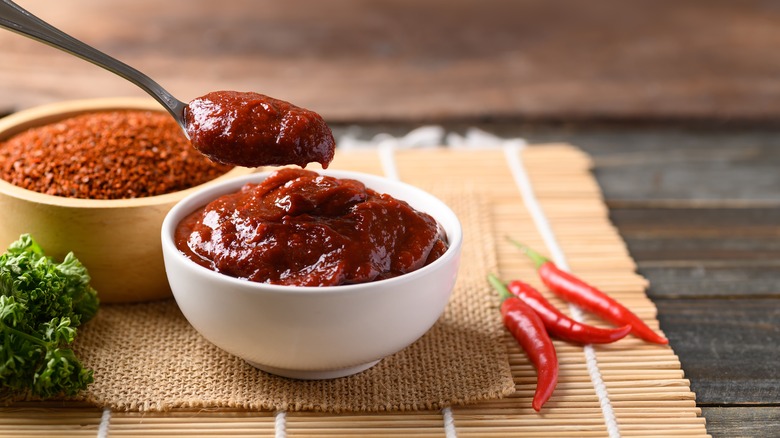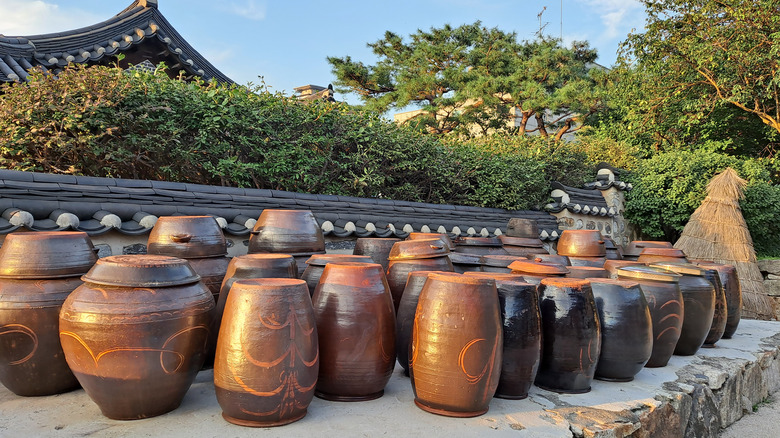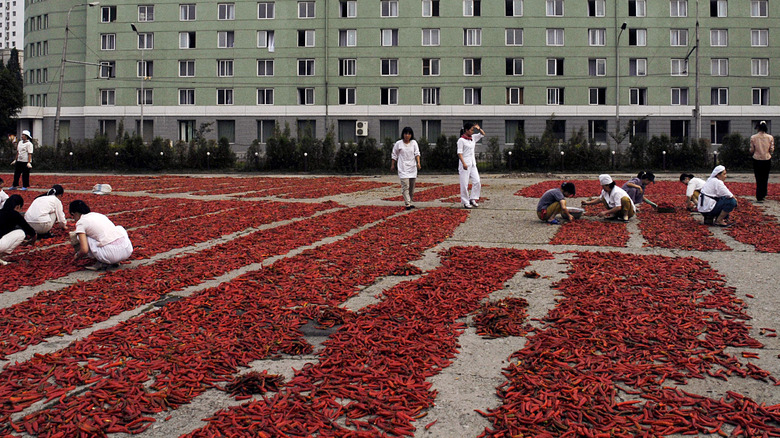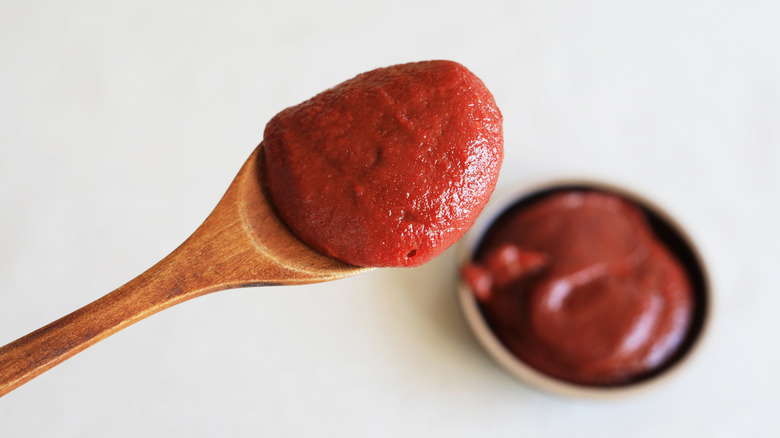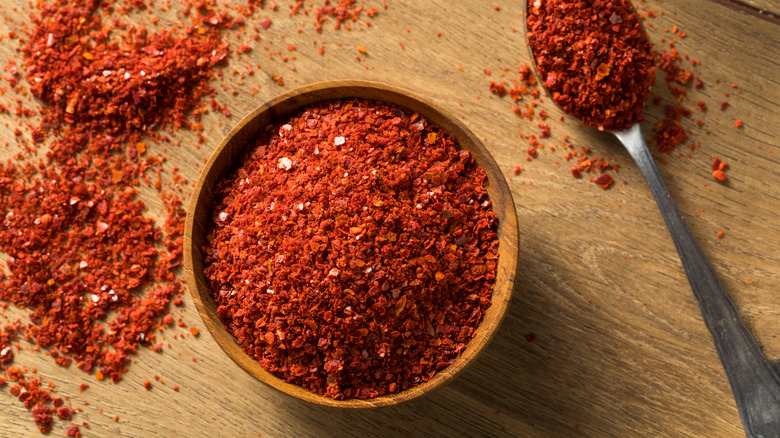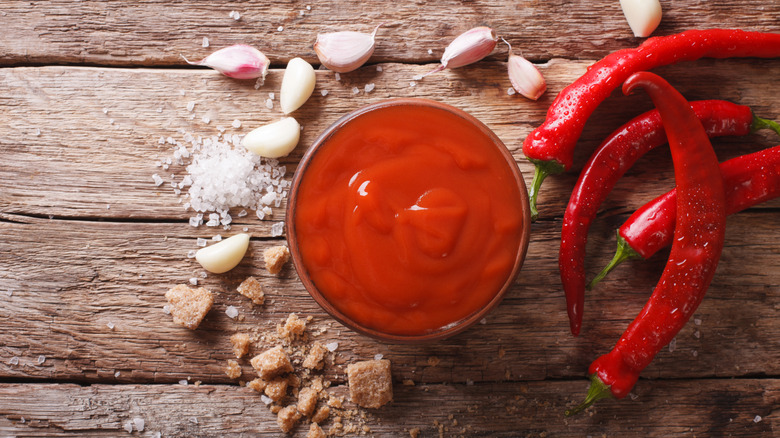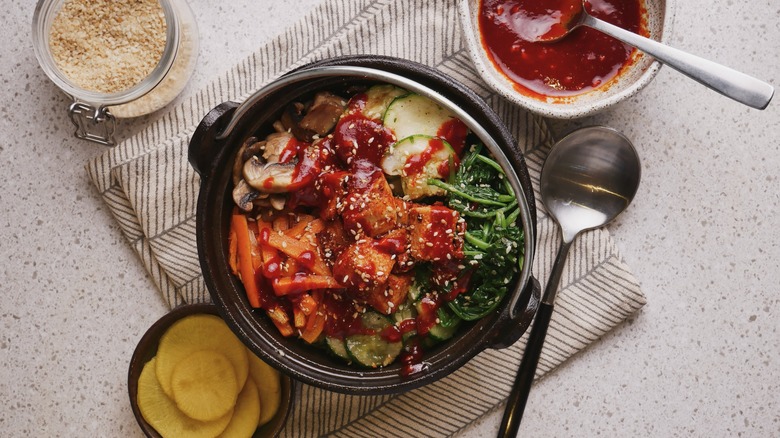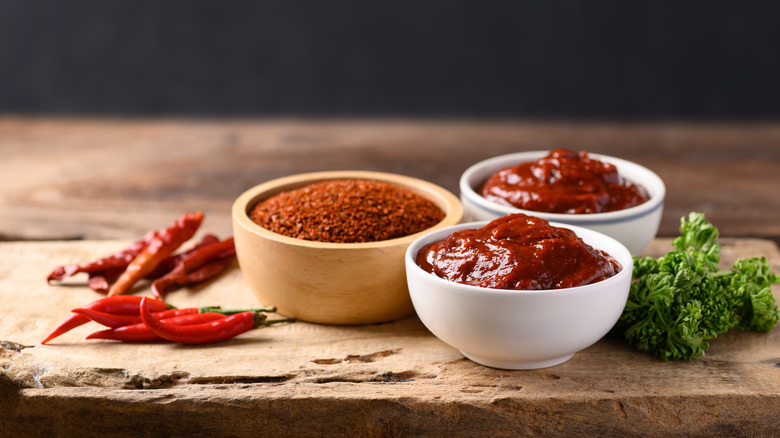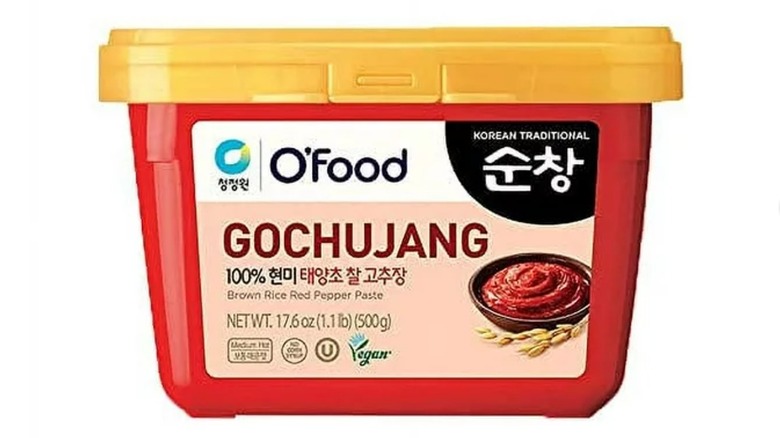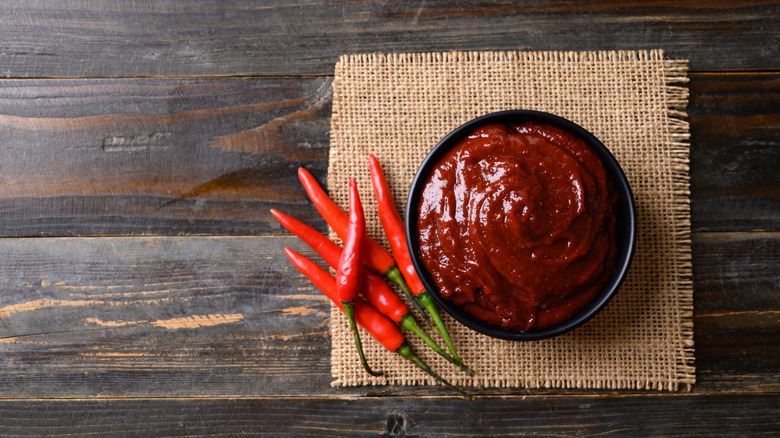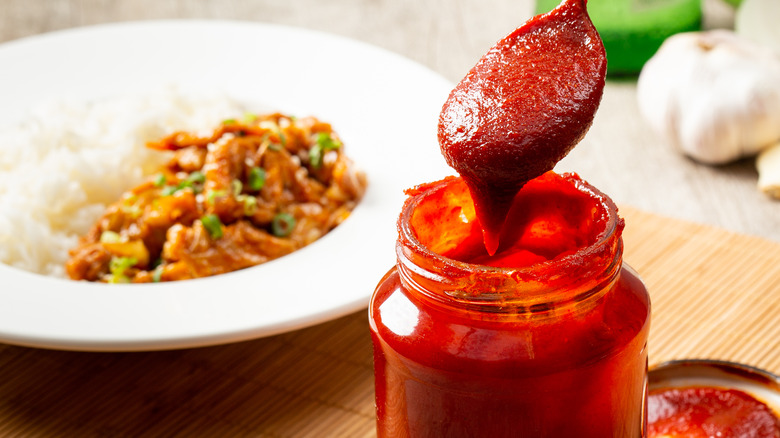What Is Gochujang And What Does It Taste Like?
We may receive a commission on purchases made from links.
Condiments, like sauces, are an invaluable component of diets in cultures across the globe. First and foremost, they confer a complexity of flavor, complementing or contrasting main ingredients by incorporating sweet, sour, salty, bitter, or umami tastes. They can also improve the texture of a dish, enhancing visual appeal by imparting moisture and color to otherwise underwhelming-looking ingredients. Finally, they can provide much-needed nutrients that may otherwise be lacking within foods.
Hot sauce is one such condiment that ranks among the most popular condiments globally. Polaris Market Research notes annual hot sauce sales hover around $2.75 billion. And Healthline touts hot sauce as one of the more nutritious condiments available. It is low in calories, and its primary ingredient, chili peppers, contains a compound known as capsaicin, which has been linked with having anti-inflammatory properties.
Virtually every culture has a version of hot sauce, such as Moroccan harissa paste, Indonesian sambal oelek, and Thailand's nam phrik. One hot sauce that seemingly has popped up overnight on virtually every menu and at myriad grocery stores is gochujang. We wanted to find out what this Korean staple is, what makes it distinct from its competitors, like sriracha, and how to use it.
What is gochujang?
Gochujang is a crimson-hued spicy condiment native to Korea. The term translates to chili sauce, with gochu meaning chili and jang being a fermented paste or sauce. Gochujang is produced by fermenting glutinous rice, fermented soybeans, barley, gochugaru or chili powder, and salt in an earthenware vat called a hangari or onggi. This sauce is a member of the cannon of jangs or fermented sauces that make up the backbone of Korean cuisine, including doenjang or soybean paste and ganjang or soy sauce.
The star ingredient in modern-day gochujang is the gochugaru or Korean chili powder made from the gochu pepper, a member of the capsicum annuum species. This species of pepper is native to the Americas and is considered the largest of the five species of peppers. It did not arrive in Asia until the 16th century when the Portuguese introduced them as part of what is known as the Columbian Exchange.
While this species of pepper is a relatively recent introduction, the preparation method for gochujang goes back much further. The earliest written record of a pepper paste dates back to 9th-century China. These seminal variations of gochujang were likely produced using a native black peppercorn or Japanese species known as chopi. Commercially produced gochujang didn't appear on the market until the 1970s.
How Is gochujang made?
Historically, gochujang was produced by placing the ingredients into the hangari or onggi and allowing them to ferment in the open air under direct sunlight for months. It is typically made during the fall and allowed to ferment from October to March. The region of Sunchang County in North Jeolla Province, south of Seoul, is considered the epicenter of gochujang production. Each year, a festival is held in Gochujang Village to celebrate the production of this condiment. Several characteristics make this area ideal for producing gochujang, including cool temperatures, superior drinking water, and high humidity, a factor necessary for the proliferation of the bacteria needed for fermentation.
While gochujang is still produced in Sunchang County, making your own at home is possible. The results may not be as sophisticated as the real deal, but it is a suitable facsimile. All you will need to produce it is miso, water, brown sugar or maple syrup, gochugaru or Korean chili peppers, salt, sake, and rice vinegar.
The process begins with melting the water and sugar until it is dissolved. Then miso and chili are added and heated until thickened. This mixture is removed from the heat and allowed to cool to 100 degrees Fahrenheit before adding the vinegar, salt, and sake. Once completely cooled, this mixture can be jarred and refrigerated for months.
What does gochujang taste like?
While some suggest that gochujang has a flavor reminiscent of sriracha combined with miso, this is overly simplistic and doesn't adequately capture the uniqueness of this condiment. The two best adjectives to describe the flavor profile of gochujang are complex and funky. While gochujang is an epic umami-bomb, its savoriness is layered with sweetness, saltiness, spiciness, and smokiness.
The savory elements are derived from the fermented soybeans, and the fermentation process gochujang undergoes itself. Sweetness stems from the glutinous rice from which it is made, the barley, and added sweeteners. Many commercially produced gochujang have been adapted to have less funkiness and more sweetness to accommodate a wider swath of the population.
The spiciness and a degree of smokiness come from the gochugaru used. Each pepper carries with it more or less inherent heat, and spice can be intensified when the seeds are dried and added to the blend before it is processed. Additionally, peppers can develop elements of a smoky quality if they have been sun-dried versus commercially dehydrated.
Gochujang versus gochugaru
Gochugaru is the Korean chili powder made from the gochu or taeyangcho pepper, a member of the capsicum annum species. This powder has a bright red hue and comes in varying degrees of spiciness depending on whether or not the seeds were removed before the chilis were dried and pulverized. Its flavor has been described as somewhat smoky and fruity. The powder is used as a seasoning in myriad dishes, including in the production of gochujang.
While gochugaru is an ingredient in gochujang, the two are quite distinct and not interchangeable in recipes. Gochujang is fermented, while gochugaru is not. This gives gochujang a unique, funky flavor characteristic of fermented foods. Additionally, they are texturally different, with gochujang being a sauce and gochugaru being a powder.
Finally, while both can vary in heat from maewoon, which is Korean for spicy, to deolmaewoon, Korean for less spicy, the average gochujang rates at less than 1,000 units on the Scoville scale, making it milder than a jalapeño for example, which typically registers between 2,500 and 8,000 units. Often, gochugaru and gochujang are used in tandem in recipes, providing complexity in both flavor and texture.
Gochujang versus sriracha
At its most basic, sriracha is a pepper sauce hailing from Thailand, while gochujang is native to Korea. Though both confer spiciness to a dish, gochujang tends to be slightly hotter than sriracha. Texturally, gochujang tends to be thicker and more like a paste, while sriracha is smoother and is more like a sauce.
Where the two differ most distinctly is in flavor. Both are rife with savory qualities, but sriracha is made with garlic, which gives it a distinct flavor. Gochujang gets most of its richness from the fermented soybeans used in its production. Additionally, the fermentation gochujang undergoes produces a complexity somewhat lacking in sriracha. Finally, the use of glutinous rice in the production of gochujang gives it a hint of sweetness and starchiness that is not present in sriracha.
While some recipes suggest the two can be used interchangeably, they are distinct enough that both can inhabit different worlds in your culinary arsenal. Some would insist that sriracha is a better tableside hot sauce than gochujang, and the latter is more suitable for amping up umami flavor in marinades. Ultimately, it comes down to your taste buds and which flavor profiles you prefer.
How to cook with gochujang
Gochujang is seldom used as is. It is typically cut with other ingredients or incorporated into recipes to temper some of its fermented funk. Traditional uses for gochujang in Korea include incorporating it into a classic bibimbap or as a base for stews like budae jjigae, dakgalbi, and tteokbokki. It is also a key ingredient in ssamjang, the delectable dipping sauce no Korean barbecue would be served without.
Its viscosity makes gochujang ideal as a glaze for meat or vegetables. It is also a fabulous addition to a marinade for meat or tofu. When used in a marinade, we recommend adding some acidity, like vinegar or lemon juice, to help tenderize your protein source.
Scoop a small quantity of gochujang into your recipe to add a hint of heat to dipping sauces or dressings. Again, be sure to pair this with plenty of acidity and a touch of nuttiness in the form of sesame or peanut oil.
Finally, toss some gochujang into your soup, stew, or stir-fry recipes to liven them up. Depending on how spicy your gochujang is, you may need to supplement your recipes with added sweetness to mellow out the heat.
What can I substitute for gochujang?
Gochujang is distinct, and no one-to-one substitute can fully encapsulate its complexity. If you are having difficulty finding it, ran out, or want something slightly mellower in heat that still has a complex, savory flavor, there are a few options. A basic rule when attempting to substitute gochujang is that no spice paste or sauce alone can do the job. You will want to combine multiple ingredients to obtain the characteristic umami, sweet, salty, smoky, and spicy flavors of gochujang. You will also want to factor in the texture, which tends to be thicker and more paste-like than other pepper sauces.
Where spicy ingredients are concerned, you could opt for sriracha, sambal oelek, harissa, nam phrik, or even dried red pepper flakes. We recommend using miso paste to get the fermented funk characteristic of gochujang. Miso will also provide a richness of texture. Try incorporating some honey, maple, rice syrup, or agave for sweetness, but don't overdo it. And finally, a touch of smoked salt or paprika can add a hint of smokiness.
Many substitutes suggest tomato sauce or paste. We disagree. There is nothing tomato-like about gochujang, and tomatoes can overpower all of the other ingredients. We also recommend avoiding overly acidic ingredients, like vinegar or lemon juices, which are not traditional to gochujang.
Where to buy gochujang
The short answer to where you can buy gochujang is everywhere. It has become so mainstream of late that you can find it in virtually every major grocery store in the U.S. If you'd like more options in brands and types, you might consider visiting an Asian grocer or specialty hot sauce store. Finally, myriad online retailers sell gochujang.
Pure gochujang paste typically comes in a red, rectangular tub in either the refrigerated section of your grocery store or the Asian or international food aisle. You can also obtain gochujang sauces in tubes and squirt bottles that are shelf-stable and located in the Asian or international foods sections of your local retailer. We would note that these sauces often have added ingredients to thin them out and make them more squirtable.
While gochujang is generally vegan and gluten-free, you should always check individual product labels to confirm this. This is doubly true for gochujang sauces. For those concerned about the spiciness of a store-bought gochujang, many containers are labeled with numbers indicating heat level, with three being moderately spicy and four being hot.
Nutritional information about gochujang
From the beginning, gochujang was recognized for its medicinal properties. It is first mentioned by name in a compilation of foods eaten at the royal court written in the 1720s by royal physician Si-pil Yi. It is also rumored to have saved King Yeongjo's life in 1748.
According to a medically reviewed article by Dany Paul Baby, MD, on WebMD, gochujang may confer several health benefits, many of which are a byproduct of the capsaicin found in the gochugaru powder from which it is made. Capsaicin has been linked with increasing metabolism, regulating blood sugar levels, being anti-cancerogenic, and aiding in alleviating pain.
One of the more conclusive research studies appearing in PubMed involved assessing the anti-inflammatory properties of gochujang for those suffering from digestive issues like colitis. This study suggested that inflammation was reduced in the gut with regular consumption of gochujang, and it contributed to an increase in healthy gut bacteria, a common finding with fermented foods.
The only contraindication with gochujang appears to be the sodium content of some commercially manufactured products. Some brands may exceed 20% of the recommended daily value per serving, which is considered high according to the FDA.
How to store gochujang
Unopened gochujang can be kept in its original container in a cool, dry place in your pantry long past its expiration date as long as the container is not tampered with or damaged. As a general rule, the expiration date has less to do with food safety than quality, and this is contingent on several factors, including exposure to heat and direct sunlight. The unopened jar will last for up to two years.
Once you open your jar of gochujang, it should always be stored in the refrigerator in an airtight container. An open jar can last for up to a year in the refrigerator. Signs of spoilage may include a strange odor, mold, noticeable changes in texture, and a shift in taste. Don't be alarmed if you notice the color changes, the ingredients have separated in the container, the jar begins to leak, or the lid forms dimples or swells. Because gochujang is a fermented product, it is a living, breathing organism that will continue to ferment, which can cause these changes in appearance.
Always be sure to reseal your jar tightly between uses to preserve the integrity of your gochujang. And use a clean spoon to scoop your gochujang out of its jar to prevent cross-contamination. Lastly, while most of us keep our condiments on the door of our refrigerator, to extend its shelf-life, you may want to store gochujang in the back of your fridge, where it is less susceptible to temperature changes.
